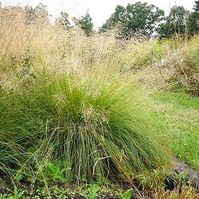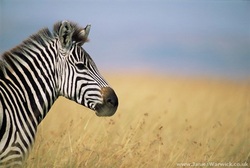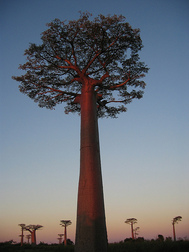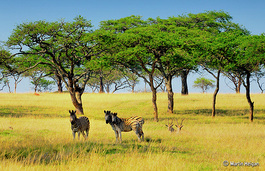Grasses - King of the Savanna
Grasses are the most common type of vegetation on the savannas. There are about 8,000 to 10,000 types of grass around the world. They are what most animals rely on for survival. These grasses are well adapted to their habitat and they can withstand annual disasters, such as bush fires and droughts. They have narrow, hallow stemmed leaves and long roots, which take up nine tenths of the whole plant. Grasses on the savanna can grow up to 3m in height. Since the leaves are narrow, they prevent the plant from dying during dry drought seasons (less evaporation). The roots are unaffected by these droughts and store nutrients for the grass to grow after the drought has passed.
Some of the grasses are 'fireproof'. This doesn't mean that they won't burn. They do burn - well the leaves do. Their growing point is at ground level so if the leaves burn down, the roots use the nutrients stored to grow the leaves back. Most trees have their growing point at the tip of their branches, so it is immediately burnt down.
Most grasses on the savannas grow in bunches - hence the name, bunch grasses. A common type of grass is the dropseed which grows up to about 5ocm in height. The red oat is also a common grass along with the hyperthelia. The red oat grows up to 50~100cm in height while the hypertheliacan grow up to 150cm or more.
The images below are and example of dropseed grass (left) and red oat grass (right). Please ignore the zebra.
The Invincible TREES
The savanna is known to be a very hard place for trees to grow. This is because of the droughts and soil (see 'Soil :)'). However, some trees, again that are well adapted to the savanna like the grasses, can survive in extreme conditions. Here are three examples:
The Acacia trees - these are the most common trees among the ones currently living in the savannas. they grow to about 10 to 20m and have throns that come in pairs. They are categorized under the pea family and are flat-topped. Animals such as the baboon, giraffe, antelope, and monkey feed on the leaves, fruit, and seeds. The acacia can survive through long droughts from 5 to 11 months. It nests many birds and becomes the shelter for many animals.
The Baobab trees - called 'the upside down tree' by the natives because of its peculiar shape, this tree can store up to 9000 litres of water in its trunk, keeping it drought resistant. It only produces small clusters of leaves in the rainy seasons and sheds all of them during the dry ones. Their height ranges from 5 to 30m and can live through a few thousand years.
The Gum Eucalyptus trees - with the average height of 20 to 30 feet, this tree grows well in sunny dry places such as Australia, California, Arizona and Nevada. It is the primary food source and home for the famous koala. The honey made from the flowers is highly prized in Australia and so are the aromatic leaves.
FUN FACT: some savannas are named after the plants that grow there, such as the acacia savanna in Africa - yes it has lots of acacia trees growing there.
The images below are examples of the Baobab tree (left) and the Acacia tree (right). Please ingore the zebras again but this time, also the antelopes.
The Acacia trees - these are the most common trees among the ones currently living in the savannas. they grow to about 10 to 20m and have throns that come in pairs. They are categorized under the pea family and are flat-topped. Animals such as the baboon, giraffe, antelope, and monkey feed on the leaves, fruit, and seeds. The acacia can survive through long droughts from 5 to 11 months. It nests many birds and becomes the shelter for many animals.
The Baobab trees - called 'the upside down tree' by the natives because of its peculiar shape, this tree can store up to 9000 litres of water in its trunk, keeping it drought resistant. It only produces small clusters of leaves in the rainy seasons and sheds all of them during the dry ones. Their height ranges from 5 to 30m and can live through a few thousand years.
The Gum Eucalyptus trees - with the average height of 20 to 30 feet, this tree grows well in sunny dry places such as Australia, California, Arizona and Nevada. It is the primary food source and home for the famous koala. The honey made from the flowers is highly prized in Australia and so are the aromatic leaves.
FUN FACT: some savannas are named after the plants that grow there, such as the acacia savanna in Africa - yes it has lots of acacia trees growing there.
The images below are examples of the Baobab tree (left) and the Acacia tree (right). Please ingore the zebras again but this time, also the antelopes.




